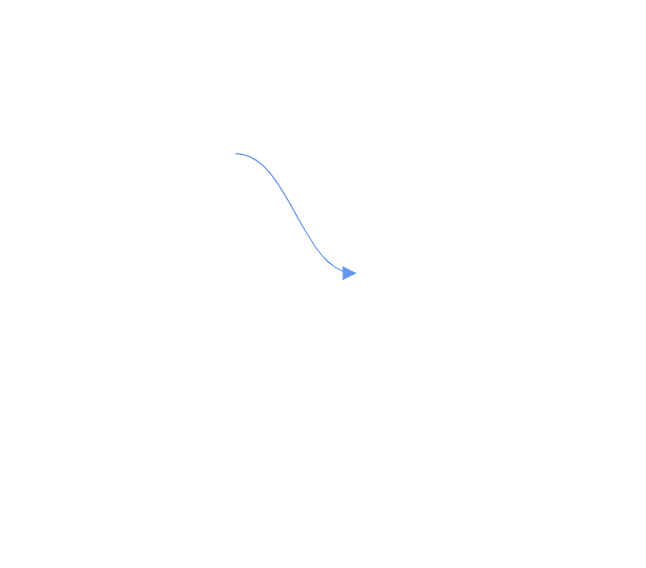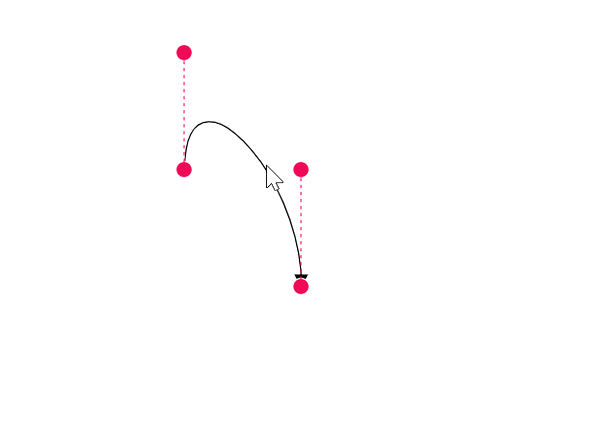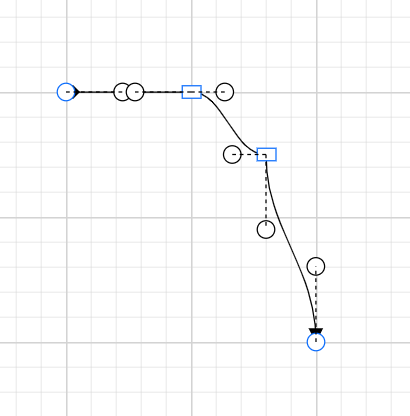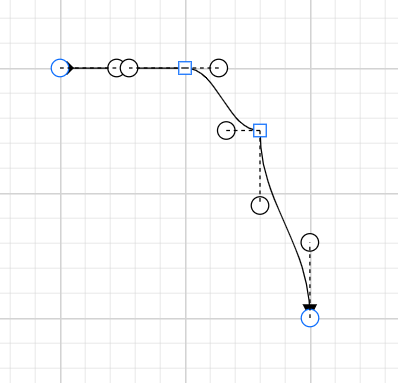Bezier Segments in Blazor Diagram Component
27 Jun 202523 minutes to read
How to Create a Bezier Segment
Bezier segments are used to create curve segments, and the curves are configurable either with control points or vectors. To create a bezier segment, set the segment Type as Bezier and specify the type for the connector. The following code example illustrates how to create a default bezier segment.
@using Syncfusion.Blazor.Diagram
<SfDiagramComponent Width="1000px" Height="500px" Connectors="@connectors">
</SfDiagramComponent>
@code
{
//Defines diagram's connector collection.
DiagramObjectCollection<Connector> connectors = new DiagramObjectCollection<Connector>();
protected override void OnInitialized()
{
Connector Connector = new Connector()
{
ID = "connector1",
SourcePoint = new DiagramPoint()
{
X = 100,
Y = 100
},
Style = new ShapeStyle() { StrokeColor = "#6f409f", StrokeWidth = 1 },
TargetPoint = new DiagramPoint() { X = 200, Y = 200 },
Type = ConnectorSegmentType.Bezier,
TargetDecorator = new DecoratorSettings()
{
Shape = DecoratorShape.Arrow,
Style = new ShapeStyle()
{
Fill = "#6f409f",
StrokeColor = "#6f409f",
StrokeWidth = 1
}
}
};
//Add the connector into connectors's collection.
connectors.Add(Connector);
}
}You can download a complete working sample from GitHub

Point1 and Point2 properties are used to control the points of the bezier connector, and the vector1 and Vector2 properties are used to define the length and angle between the source point and target point, respectively. The following code example illustrates how to use these properties in our control.
Connector Connector1 = new Connector()
{
ID = "Connector1",
Type = ConnectorSegmentType.Bezier,
SourcePoint = new DiagramPoint { X = 500, Y = 200 },
TargetPoint = new DiagramPoint { X = 600, Y = 300 },
Segments = new DiagramObjectCollection<ConnectorSegment>
{
new BezierSegment()
{
Type = ConnectorSegmentType.Bezier,
//Defines the point1 and point2 for the bezier connector.
Point1 = new DiagramPoint { X = 500, Y = 100 },
Point2 = new DiagramPoint { X = 600, Y = 200 }
}
}
};
Connector Connector2 = new Connector()
{
ID = "Connector2",
Type = ConnectorSegmentType.Bezier,
SourcePoint = new DiagramPoint { X = 200, Y = 100 },
TargetPoint = new DiagramPoint { X = 300, Y = 200 },
Segments = new DiagramObjectCollection<ConnectorSegment>
{
new BezierSegment()
{
Type = ConnectorSegmentType.Bezier,
//Defines the Vector1 and Vector2 for the bezier connector.
Vector1 = new Vector(){Distance = 100 ,Angle = 90 },
Vector2 = new Vector(){Distance = 45 ,Angle = 45 }
}
}
};You can download a complete working sample from GitHub
How to Edit Bezier Segments
- A segment control point of the Bezier connector is used to change the bezier vectors and points of the connector.

How to Avoid Overlapping with Bezier
By default, when there are no segments defined for a bezier connector, the bezier segments will be created automatically and routed in such a way that avoids overlapping with the source and target nodes.
@using Syncfusion.Blazor.Diagram
<SfDiagramComponent Width="1000px" Height="500px" Nodes="@nodes" Connectors="@connectors"></SfDiagramComponent>
@code {
//Define the diagram's connector collection.
DiagramObjectCollection<Connector> connectors = new DiagramObjectCollection<Connector>();
//Define the diagram's node collection.
DiagramObjectCollection<Node> nodes = new DiagramObjectCollection<Node>();
protected override void OnInitialized()
{
nodes.Add(
new Node()
{
ID = "node1",
OffsetX = 300,
OffsetY = 100,
Width = 100,
Height = 100,
Ports = new DiagramObjectCollection<PointPort>()
{
new PointPort()
{
ID="Port1",
Visibility = PortVisibility.Visible,
Offset = new DiagramPoint() { X = 1, Y = 0.5 },
},
}
});
nodes.Add(new Node()
{
ID = "node2",
OffsetX = 300,
OffsetY = 350,
Width = 100,
Height = 100,
Ports = new DiagramObjectCollection<PointPort>()
{
new PointPort()
{
ID="Port1",
Visibility = PortVisibility.Visible,
Offset = new DiagramPoint() { X = 0, Y = 0.5 },
},
}
});
Connector connector1 = new Connector()
{
ID = "connector1",
SourceID = "node1",
TargetID = "node2",
SourcePortID = "Port1",
TargetPortID = "Port1",
Type = ConnectorSegmentType.Bezier,
Constraints = ConnectorConstraints.Default | ConnectorConstraints.DragSegmentThumb
};
connectors.Add(connector1);
}
}You can download a complete working sample from GitHub.
Also, if you provide segments during the initial rendering, the segment collection will be updated dynamically when you move the connector ends. If you do not want the segments to be updated dynamically when you move the connector end, you need to set BezierConnectorSettings.AllowSegmentsReset as False.
@using Syncfusion.Blazor.Diagram
<SfDiagramComponent Width="1000px" Height="500px" Nodes="@nodes" Connectors="@connectors"></SfDiagramComponent>
@code {
//Define the diagram's connector collection.
DiagramObjectCollection<Connector> connectors = new DiagramObjectCollection<Connector>();
//Define the diagram's node collection.
DiagramObjectCollection<Node> nodes = new DiagramObjectCollection<Node>();
protected override void OnInitialized()
{
nodes.Add(
new Node()
{
ID = "node1",
OffsetX = 300,
OffsetY = 100,
Width = 100,
Height = 100,
Ports = new DiagramObjectCollection<PointPort>()
{
new PointPort()
{
ID="Port1",
Visibility = PortVisibility.Visible,
Offset = new DiagramPoint() { X = 1, Y = 0.5 },
},
}
});
nodes.Add(new Node()
{
ID = "node2",
OffsetX = 300,
OffsetY = 350,
Width = 100,
Height = 100,
Ports = new DiagramObjectCollection<PointPort>()
{
new PointPort()
{
ID="Port1",
Visibility = PortVisibility.Visible,
Offset = new DiagramPoint() { X = 0, Y = 0.5 },
},
}
});
Connector connector1 = new Connector()
{
ID = "connector1",
SourceID = "node1",
TargetID = "node2",
SourcePortID = "Port1",
TargetPortID = "Port1",
Type = ConnectorSegmentType.Bezier,
Segments = new DiagramObjectCollection<ConnectorSegment>(){new BezierSegment(){Type = ConnectorSegmentType.Bezier}},
//Define whether to reset the current segments collection in response to change in the connector ends.
BezierConnectorSettings = new BezierConnectorSettings() { AllowSegmentsReset = false },
Constraints = ConnectorConstraints.Default | ConnectorConstraints.DragSegmentThumb
};
connectors.Add(connector1);
}
}You can download a complete working sample from GitHub.

How to Customize Bezier Segment Thumb Shape
The Bezier connector can have multiple segments between the source and target points. By default, these segments are rendered as circles, but this can be customized either globally or for individual connectors using the SegmentThumbSettings class.
To change the segment thumb shape for all Bezier connectors, configure the SegmentThumbSettings property of the SfDiagramComponent class and set the Shape property to the desired shape.
To customize the segment thumb shape for a specific connector, first disable the InheritSegmentThumbShape constraint. Then, configure the SegmentThumbSettings property of the Connector class, specifying the desired shape using the Shape property of the SegmentThumbSettings class.
The following predefined shapes are provided:
| Shape name | Shape |
|---|---|
| Rhombus |  |
| Square |  |
| Rectangle |  |
| Ellipse |  |
| Circle |  |
| Arrow |  |
| OpenArrow |  |
| Fletch |  |
| OpenFetch |  |
| IndentedArrow |  |
| OutdentedArrow |  |
| DoubleArrow |  |
The following code example illustrates how to create a customized bezier segment thumb shape using the InheritSegmentThumbShape constraints.
@using Syncfusion.Blazor.Diagram
@using Syncfusion.Blazor.Diagram.Internal
<SfDiagramComponent Width="1000px" Height="500px" Connectors="@connectors" ConnectorSegmentThumb="@connectorSegmentThumb"></SfDiagramComponent>
@code {
//Define the diagram's connector collection.
DiagramObjectCollection<Connector> connectors = new DiagramObjectCollection<Connector>();
//Define the segment shape
SegmentThumbSettings connectorSegmentThumb = new SegmentThumbSettings() { Shape = SegmentThumbShapes.Rectangle };
protected override void OnInitialized()
{
Connector connector = new Connector()
{
ID = "connector",
SourcePoint = new DiagramPoint() { X = 100, Y = 100 },
TargetPoint = new DiagramPoint() { X = 300, Y =300 },
SourceDecorator = new DecoratorSettings() { Shape = DecoratorShape.Diamond },
Segments = new DiagramObjectCollection<ConnectorSegment>()
{
new BezierSegment(){Type = ConnectorSegmentType.Bezier, Point = new DiagramPoint(){X = 200, Y = 100}
,
},
new BezierSegment(){Type = ConnectorSegmentType.Bezier, Point = new DiagramPoint(){X = 260, Y = 150}}
},
Type = ConnectorSegmentType.Bezier,
BezierConnectorSettings = new BezierConnectorSettings()
{
ControlPointsVisibility = ControlPointsVisibility.All
},
Constraints = ConnectorConstraints.Default | ConnectorConstraints.DragSegmentThumb | ConnectorConstraints.InheritSegmentThumbShape,
};
connectors.Add(connector);
}
}You can download a complete working sample from GitHub.

The following code example illustrates how to create a customized bezier segment thumb shape without using the InheritSegmentThumbShape constraints.
@using Syncfusion.Blazor.Diagram
@using Syncfusion.Blazor.Diagram.Internal
<SfDiagramComponent Width="1000px" Height="500px" Connectors="@connectors" ></SfDiagramComponent>
@code {
//Define the diagram's connector collection.
DiagramObjectCollection<Connector> connectors = new DiagramObjectCollection<Connector>();
protected override void OnInitialized()
{
Connector connector = new Connector()
{
ID = "connector",
SourcePoint = new DiagramPoint() { X = 100, Y = 100 },
TargetPoint = new DiagramPoint() { X = 300, Y =300 },
SourceDecorator = new DecoratorSettings() { Shape = DecoratorShape.Diamond },
Segments = new DiagramObjectCollection<ConnectorSegment>()
{
new BezierSegment(){Type = ConnectorSegmentType.Bezier, Point = new DiagramPoint(){X = 200, Y = 100}
,
},
new BezierSegment(){Type = ConnectorSegmentType.Bezier, Point = new DiagramPoint(){X = 260, Y = 150}}
},
Type = ConnectorSegmentType.Bezier,
BezierConnectorSettings = new BezierConnectorSettings()
{
ControlPointsVisibility = ControlPointsVisibility.All
},
Constraints = ConnectorConstraints.Default | ConnectorConstraints.DragSegmentThumb,
SegmentThumbSettings = new SegmentThumbSettings() { Shape = SegmentThumbShapes.Square},
};
connectors.Add(connector);
}
}You can download a complete working sample from GitHub.

Note: This feature ensures that the shape is updated regardless of whether the InheritSegmentThumbShape enum value is added to the Constraints property of the diagram. If you apply the InheritSegmentThumbShape constraints, the shape will be updated at the diagram level. Without these constraints, the shape will be updated at the connector level.
To make the shapes visible, ensure that the DragSegmentThumb enum is added to the connector’s constraints.